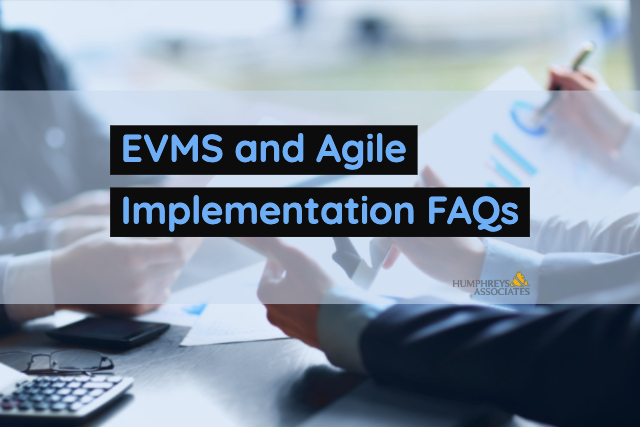EVMS and Agile Implementation FAQ’s
by Humphreys & Associates | February 4, 2016 7:02 am

These are some of the frequently asked questions we receive when discussing EVMS and Agile implementations within the same company or on the same project.
Question 1: What documentation do you have that I can use to help me understand EVMS and Agile and how they are implemented?
Answer 1: There is expansive EVMS documentation, and the EVMS guidelines are well documented. On the other hand, there is little in the way of Agile documentation since the Agile mindset is to be lean and not to document unless absolutely necessary. The DOD released an
EVMS and Agile Program Manager’s Desk Guide that can be used for quick reference. H&A has done the homework and has created training for EVMS and Agile.
Question 2: What is the comparable Agile term or artifact for this EVMS artifact (for example the WBS)?
Answer 2: There is no roadmap between EVMS and Agile that is hard and fast. The best approach would be to identify “similar to” situations or likenesses. For example the EVMS WBS is similar to the Product Backlog within Agile. The Steering Committee of The World Congress in Computer Science, Computer Engineering and Applied Computing reported on Constructs to Support Agile and EVMS
Question 3: What roles within the PMO are there for EVMS and for Agile and how do they relate?
Answer 3: In Agile there is no real “management” role. So the PMO roles that are management titled are not germane to Agile. And in the opposite direction, the Agile roles do not really exist within EVMS. For example the Agile “Product Owner” is a person with a customer view of the product and speaks for the customer. In a stretch this could be a high level Software or System Engineer with requirements responsibilities. The Scrum Master is a facilitator on the Scrum team and there is no corresponding EVMS role. The team members organize themselves so there is no team lead like the Control Account manager in an EVM System.
Question 4: Since the Sprint in the Agile/Scrum approach is defined as a time-box with a fixed end date, how do you reconcile that with the EVMS approach of working the task until it is done?
Answer 4: The EVMS baseline can be set above the Sprint level and can correspond to known “mandatory” delivery points such as release deliveries. This will then align the Agile deliveries to the EVMS structure and the two can work together.
Question 5: Does the fact that Agile/Scrum Sprints have very short durations cause a problem with EVMS performance measurement?
Answer 5: Not at all since teams update their progress daily. But it is preferable if the Sprints are four weeks or less and align with the cut-off dates for the EVMS. In that way the EVMS can pull the stated performance from the teams and use it as the input for the EVMS without any translation work. If a Sprint crosses an EVMS period, that would need special consideration.
Question 6: Since Agile work is not really budgeted, how does that reconcile with the EVMS need for budgets and budget control?
Answer 6: Budgets will be held in packages in the EVMS based on the plan for the Sprints and the teams doing the Sprints. The Agile weighting of work will be within the same packages but is not considered to be budgeting; it is weighting of milestones, if anything.
Question 7: We do not like the idea of the 0/100 EV Technique even with milestones. At our company we have an allowance to earn partial credit for milestone work. How does that fit into the EVMS and Agile implementations?
Answer 7: Agile wants to measure work when done. The work should be in such small stories, or tasks, that they are in-process for only a matter of days. Partial credit should not be needed in this situation; if it is, then perhaps there are issues with work definition.
Question 8: Agile applies to software development, but can we use it for other types of work?
Answer 8: Yes. It is a misconception that Agile is for software only. If you are creative you can find ways to use Agile Development in many areas. One company reports it uses it for circuit design and breadboarding resulting in significant time savings.
For additional information about EVMS and Agile see the blog post:
Agile/Scrum Ceremonies and Metrics Useful in EVMS Variance Analysis and Corrective Action
Source URL: https://blog.humphreys-assoc.com/faqs-evms-agile-implementations/